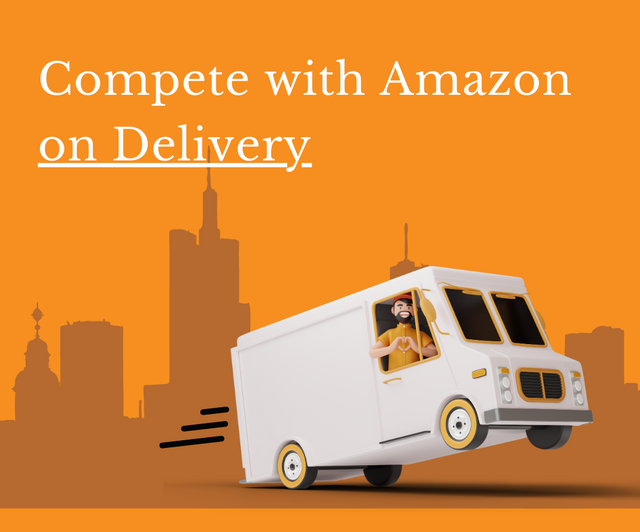How eCommerce Businesses Can Compete With Amazon On Delivery
For what seems like forever now, Amazon has set the standard for a seamless delivery experience. The era of one-size-fits-all shipping has now sailed away, and to keep afloat, eCommerce businesses are required to deliver personalised shipping experiences that cater to the unique needs and preferences of each customer. In this article, we discuss the strategies and solutions that can help eCommerce stores compete with giants like Amazon on delivery. We’ll focus on the importance of offering a variety of shipping speed options, providing free shipping when feasible, and above all, ensuring clear and accurate delivery dates.
Let’s ship it!
The Significance of Personalising Shipping Experiences to Increase Conversions
Contrary to popular belief, shipping isn’t just about labels and logistics. It plays a pivotal role in influencing a customer’s purchase decision, starting right in the cart. Customers evaluate their purchases based on the shipping information provided, even before they commit to buying. According to research, 90% of shoppers state that the shipping experience constitutes at least half of their overall online shopping experience*. This might explain why an unsatisfactory shipping experience leads to a staggering 61% of shoppers abandoning their carts*.
It’s clear that improving the shipping experience with personalised solutions can significantly boost conversions. Consider a customer who has ordered a birthday gift and needs it to arrive on a specific date. Offering a range of delivery options that allow the customer to choose the one that ensures the gift arrives on time can greatly enhance their shopping experience, and increase the likelihood of finalising the purchase.
Investing in the shipping experience at checkout can do wonders in fostering trust and loyalty among your customers. The transparency it provides shapes the customer’s demand and expectations, helping to build a long-term relationship. Such investment has the potential to increase conversion rates, as it offers speed, convenience, and transparency to your customers.
Delivery Date and Split Shipping: Emerging Trends in Conversion Strategies
A striking 85% of consumers demand full visibility into shipping timelines before making any online purchase**. This statistic underscores the importance of providing clear and accurate delivery dates, which can serve as potent conversion bait. It’s essential that businesses understand the significance of this requirement and implement strategies to meet it. With a commitment to satisfying consumer expectations, eCommerce stores can take several steps to ensure transparency and reliability in delivery schedules:
- Introduce prominent labels for fast delivery options that make them instantly recognisable and appealing.
- Include delivery dates in the shopping cart and during the checkout process. This helps to reassure customers and prevents last-minute dropouts caused by uncertainty about delivery times.
- To make shipping timelines visible early in the browsing stage, highlight delivery dates on category or listing pages.
- Provide detailed delivery information on product pages to ensure that even if a customer has navigated directly to a specific product page, they still have access to clear shipping timelines.
Besides ensuring visibility of shipping timelines, there’s another strategy that can significantly improve customer experience: split shipping. The concept of split shipping involves providing the customer with the flexibility to have different items in their order delivered at different times. This can be particularly beneficial in scenarios where a customer’s needs vary across different products.
Consider, for example, a customer who is ordering several items for different purposes – a book for leisure reading, a kitchen gadget needed for a dinner party in three days, and a piece of furniture that’s not urgently needed. Providing the option for split shipping – allowing each item to be delivered at a different time – can greatly enhance the customer’s shopping experience. The customer can choose to have the book and kitchen gadget delivered in two days, and opt for a slower, cheaper delivery option for the furniture.
Split shipping is a win-win for both customers and businesses. Customers get their items when they need them, and businesses can efficiently manage their shipping resources. Moreover, this approach allows businesses to preemptively address potential fulfilment issues and better manage customer expectations.
Navigating Shipping Complexities: The Need for Robust Solutions
Running an eCommerce business comes with a multitude of challenges, especially when shipping products that require complex solutions – such as restricted items, perishable products, or products shipped from multiple warehouses. There are tools available, like ShipperHQ, that are equipped to tackle these complexities head-on, offering solutions for various scenarios:
- Products requiring rules based on geographic zones, specific products, prices, weights, etc, like bulky objects, perishable items, restricted sale products. For example, a business selling furniture (bulky objects) and home decor (smaller items) might need to set different shipping rules for these products based on their size and weight.
- Offering in-store pickup at specific locations for specific products. A local business might want to offer customers the option to pick up their orders from the store to save on shipping costs.
- Multi-origin shipping directly from vendors or from multiple distribution centres. This can be particularly useful for businesses with a large inventory spread across various locations.
- Rate Shopping, ensuring customers receive the lowest prices for their shipping needs at dates convenient for them. This feature allows customers to compare different shipping options and choose the one that best suits their needs and budget.
Use Returns Policy To Avoid Doubt In the Purchasing Experience
Just as a smooth shipping experience is vital for customer satisfaction, a returns policy can also significantly influence a customer’s perception of your brand. A clear and transparent return policy can ease a customer’s apprehensions about purchasing from your online store, particularly when buying items like clothing that need to fit properly. A survey by Narvar found that 49% of shoppers check the retailer’s return policy before making an online purchase***, highlighting the importance of a comprehensive and customer-friendly return policy.
It’s important to maintain the right balance between a hassle-free returns policy to avoid doubt in the purchasing experience, and preventing the increase in the rate of returns by giving customers a window for buyer’s remorse. You want to employ a robust return policy that offers a lengthy window for returns and shows customers the returns process, but at the same time, it’s crucial to ensure the policy does not inadvertently incentivise unnecessary or impulsive returns. The key is to foster customer trust and satisfaction without creating a system that can be easily exploited or one that results in significant loss for the business.
The Solutions to Compete on eCommerce Delivery Narrative
When competing with Amazon, personalised shipping solutions are the number one way for eCommerce businesses to elevate the customer experience and increase conversions. One solution that we often recommend to our clients is ShipperHQ. ShipperHQ is a shipping rate management platform that offers eCommerce stores access to top-notch shipping tools, from crafting personalised shipping options that chime with customers, to offering split shipping and tackling complex shipping scenarios with ease.
ShipperHQ integrates seamlessly with platforms like Magento, giving businesses the means to offer bespoke buying journeys. All these factors collectively craft a delivery narrative that not only matches but potentially outshines the standards set by Amazon, leading to increased conversions and customer loyalty. Additionally, enterprise customers receive the Enhanced Checkout feature at no extra cost. This feature empowers merchants to integrate with headless commerce solutions and Progressive Web Application (PWA) themes, offering the fastest and most customisable buying experience possible.
For instance, a business using the Enhanced Checkout feature can create a checkout experience that allows customers to easily add or remove items from their cart, select their preferred shipping options, apply discount codes, and view the total cost of their order, all on a single, streamlined page. This seamless experience can significantly improve conversion rates and enhance customer satisfaction.
Conclusion: Personalisation and Innovation – The Keys to Compete with Giants
How many times have you found yourself navigating through the purchase process in a retailer’s store, only to abandon your cart at the final stages of checkout as you are presented with too slow or too expensive shipping options.
The enemy of successful eCommerce is friction, particularly where shipping is concerned, as it is one of the highest friction factors. To reduce this friction, businesses need to focus on providing clear, upfront and diverse shipping options tailored to the customer’s needs. This approach facilitates swift decision-making for customers and eliminates reasons for them to leave later in the purchase journey. Remember, it is pivotal that no stage in this journey gives the customer a reason to leave, especially after you’ve worked so hard to guide them there.
In the end, shipping is more than just a necessary part of the eCommerce process; it’s a powerful tool that can be used to create a more personalised, customer-centric shopping experience. By focusing on the delivery narrative and leveraging the right tools, eCommerce businesses can not only compete with Amazon but also carve out their own unique space in the market. The key to success lies in understanding customer needs, providing flexible and transparent shipping options, and continuously innovating to improve the shopping experience.
If you want to learn more about UX & storytelling eCommerce strategies that can help you compete on delivery with Amazon, watch out webinar below!


